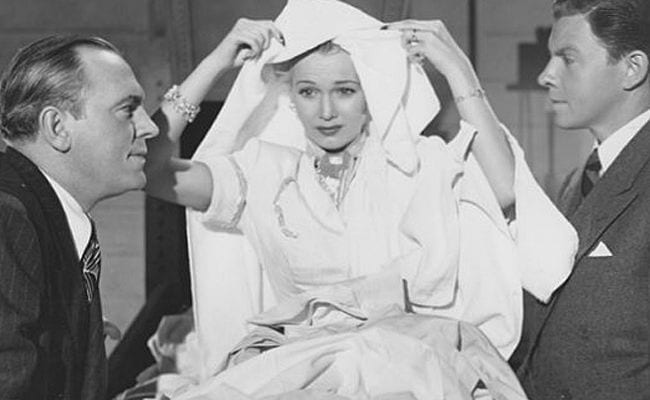
In theory, this double-feature of B comedy-mysteries use the same hero. In practice, they have nothing in common — not the actors, characterizations, nor even the studio. Yet here they are, together at last, on demand from Warner Archive.
Hailing from the deepest ’40s, Having Wonderful Crime is bright and madcap enough to get wearisome fast. We’re given to understand that put-upon Chicago attorney John J. Malone (Pat O’Brien in constant slow burn) is forever beset by two loud, laughing, bubble-headed chums who are now freshly married, Jake (George Murphy, practically delirious) and Helene Justus (Carole Landis, dressed to kill). For reasons that have something to do with having wrapped up a murder case by leaving an unconscious man in Malone’s office, they all decide to skip town (we can’t figure it either) and wind up in a honeymoon hotel (“I’m broad-minded,” says Malone) with an odd foreign gal (Lenore Aubert) and a be-sworded magician (George Zucco), and everyone runs around instead of calling the cops.
The model for this zany triangle would appear to be Thorne Smith’s novels and movies about Topper and a married couple of cocktail-swilling ghosts, but no, the real basis is a mystery novel by Craig Rice (a pseudonym of Georgiana Craig), who achieved popularity with her mix of hardboiled crime and screwball comedy. Leonard Maltin’s film guide avers that the movie is based very loosely on the book, and we should hope so, as it’s very loose in any case.
This RKO production was helmed by prolific comedy director Eddie Sutherland, perhaps accounting for the presence of silent comedians Vernon Dent and Chester Conklin in bit roles. Malone was later played by Brian Donlevy in The Lucky Stiff (1949), an independent item from United Artists; it’s not here. For that matter, Lee Tracy starred in a short-lived TV series called The Amazing Mr. Malone (1951-52) that we’d like to see, but it’s not around either.

Mrs. O’Malley and Mr. Malone (1950, dir. Norman Taurog)
Instead, what we have next is a typically polished MGM B-picture, Mrs. O’Malley and Mr. Malone, based on a story by Rice and frequent collaborator Stuart Palmer called “Once Upon a Train, or The Loco Motive”. That story featured Palmer’s schoolteacher Hildegarde Withers, the subject of her own series of films, but here she’s replaced with a typical Marjorie Main persona. This is a much harsher, wittier, more cynical comedy than Having Wonderful Crime, and the plot is tighter, too, so kudos to writer William Bowers for handling this story set mostly on a train from Chicago to New York and even pulling off a few well-timed surprises.
The film opens with tart-tongued Montana widow Harriet O’Malley (Main, with many of the best lines and one absurd song delivered in her freight-train voice) winning a pile of cash in a radio contest. That’s why she’s on the same train as Malone (James Whitmore), who’s pursuing a debunking client with his own pile of cash. This conception of Malone is an amusingly down-at-heels reprobate who twists the law like taffy in pursuit of a semi-dishonest dollar when he’s not hitting on dames and blowing dough on horses and booze; he’s introduced in an especially funny manner at the city morgue. In other words, he’s a workable character, and Mrs. O’Malley takes him in stride because he reminds her of her late husband.
The plot is a grimly amusing exploitation of that old standby, the vanishing or traveling corpse (thus ingeniously reprising the morgue joke), as various characters hustle it around in anticipation of such later films as The Trouble with Harry and Weekend at Bernie’s. This frantic yet blasé morbidity is well handled by the game cast, which includes Ann Dvorak, Dorothy Malone, Fred Clark, Phyllis Kirk, Clinton Sundberg, Douglas Fowley, Don Porter, and Frank Cady.
If the earlier movie made 70 minutes feel like 90, this one makes it feel like 60, and the secret is that these characters seem smart instead of demented. They’re reacting to their crazy situation instead of creating craziness unnecessarily. In other words, the proceedings are wacky but the characters not so much, and that prevents them from becoming tiresome. It’s handled by another veteran comedy director, Norman Taurog, whose career stretched from W.C. Fields to Jerry Lewis before he finished on Elvis Presley vehicles. Both prints look excellent, and the second film comes with a trailer that advertises it as if possibly launching a new series that, alas, never materialized.


![Call for Papers: All Things Reconsidered [MUSIC] May-August 2024](https://www.popmatters.com/wp-content/uploads/2024/04/all-things-reconsidered-call-music-may-2024-720x380.jpg)



